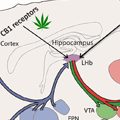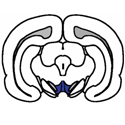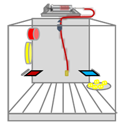Dr. Amy Janes has officially joined the NIDA IRP as a new Investigator within the Neuroimaging Research Branch (NRB). Dr. Janes will lead the newly created Cognitive and Pharmacological Neuroimaging Unit where she will build upon her highly successful clinical and translational work that includes investigations of comorbidity between SUDs and mental health disorders. Dr…. [Read More]
News Main
Sex differences in the effect of chronic delivery of the buprenorphine analog BU08028 on heroin relapse and choice in a rat model of opioid maintenance
Hot Off the Press – October 12, 2021 Previous studies reported that the NOP/µ receptor partial agonist BU08028 produced antinociception in rodents and non-human primates and is not self-administered by non-human primates, leading to the suggestion that BU08028 can be a promising candidate for opioid addiction treatment. In a buprenorphine-validated rat model of opioid agonist… [Read More]
Lateral habenula cannabinoid CB1 receptor involvement in drug-associated impulsive behavior
Featured Paper of the Month – October 2021
Published in Neuropharmacology by Agustin Zapata and Carl R Lupica in the NIDA IRP Electrophysiology Research Section.
Studies show that cannabis increases relapse to cocaine seeking following withdrawal, and in humans cannabis and cocaine use are associated with impulse control deficits. We showed previously that an area of the brain known as the lateral habenula (LHb) is involved in inhibiting operant responses for cocaine in rat self-administration studies. Therefore, the present study was conducted to determine if the LHb controls impulsivity caused by acute cocaine or the primary psychoactive component of cannabis know as Δ9-tetrahydrocannabinol (Δ9-THC)…
G protein-coupled receptor-effector macromolecular membrane assemblies (GEMMAs)
Reviews To Read – September 2021. Published in Pharmacology & Therapeutics by Sergi Ferré, et al. G protein-coupled receptors (GPCRs) are the largest group of receptors involved in cellular signaling across the plasma membrane and a major class of drug targets. The canonical model for GPCR signaling involves three components — the GPCR, a heterotrimeric… [Read More]
A closer look at alcohol-induced changes in the ghrelin system: novel insights from preclinical and clinical data
Featured Paper of the Month – September 2021
Published in Addiction Biology by Sara Deschaine, Mehdi Farokhnia, and Lorenzo Leggio et al. in the NIDA IRP Clinical Psychoneuroendocrinology and Neuropsychopharmacology Section.
Growing evidence shows that ghrelin, a gastric-derived peptide hormone, is involved in regulation of alcohol seeking behavior. Accordingly, the ghrelin system is being studies as a potential pharmacotherapeutic target for alcohol use disorder (AUD). The reverse side of this bidirectional link, i.e., the effects that alcohol may have on the ghrelin system, is not well understood. In a series of preclinical and clinical experiments, the present study aimed to investigate the impact of alcohol on different elements of the ghrelin system.
The protective effect of operant social reward on cocaine self-administration, choice, and relapse is dependent on delay and effort for the social reward
Hot Off the Press – August 24, 2021 In humans who use addictive drugs, social-reinforcement-based treatments can protect against drug use and relapse, but not in all patients. We used a new operant rat model that mimics features of one such treatment, the community-reinforcement approach; having previously shown that rats choose social reinforcement over heroin… [Read More]
Marisela Morales Awarded 2020 NIH Green Labs Program Certificate
Congratulations to our 2021 Mentoring Award winners! They were honored at the 9th NIDA Poster Day and Mentoring Awards ceremony on May 19, 2021. From left to right: Huilng Wang, MD, PhD – Diversity Mentoring Award; David Reiner, PhD – Postdoctoral Fellow Mentoring Award; Bruce Hope, PhD – Investigator Mentoring Award; and Jeremiah Bertz, PhD – Staff Scientist Mentoring Award.
Ventral tegmental area GABA, glutamate, and glutamate-GABA neurons are heterogeneous in their electrophysiological and pharmacological properties
Featured Paper of the Month – August 2021
Published in European Journal of Neuroscience by Jorge Miranda-Barrientos and Marisela Morales, et al. in the NIDA IRP Neuronal Networks Section.
The ventral tegmental area (VTA) contains dopamine neurons intermixed with GABA-releasing (expressing vesicular GABA transporter, VGaT), glutamate-releasing (expressing vesicular glutamate transporter 2, VGluT2), and glutamate-GABA co-releasing (co-expressing VGluT2 and VGaT) neurons. By delivering INTRSECT viral vectors into the VTA of double vglut2-Cre/vgat-Flp transgenic mice, we targeted specific VTA cell populations for ex vivo recordings. We found that VGluT2+ VGaT- and VGluT2+ VGaT+ neurons on average had relatively hyperpolarized resting membrane potential, greater rheobase, and lower spontaneous firing frequency compared to VGluT2- VGaT+ neurons, suggesting that VTA glutamate-releasing and glutamate-GABA co-releasing neurons require stronger excitatory drive to fire than GABA-releasing neurons…
Animal Models of Drug Relapse and Craving after Voluntary Abstinence: A Review
Reviews To Read – July 2021. Our review describes recently developed rat models of relapse after voluntary abstinence, achieved either by introducing adverse consequences to drug taking or seeking or by providing mutually exclusive choices between the self-administered drug and nondrug rewards. We discuss recent neuropharmacological findings from studies using these models, future directions, and… [Read More]
Inactivation of the infralimbic cortex decreases discriminative stimulus-controlled relapse to cocaine seeking in rats
Hot Off the Press – July 7, 2021 Published in Neuropsychopharmacology by Rajtarun Madangopal and Bruce Hope, et al. in the NIDA IRP Neuronal Ensembles in Drug Addiction Section. Discriminative stimuli (DSs) play an important and understudied role in the persistent susceptibility to drug relapse. They signal drug availability (DS+) or unavailability (DS-) and control… [Read More]










